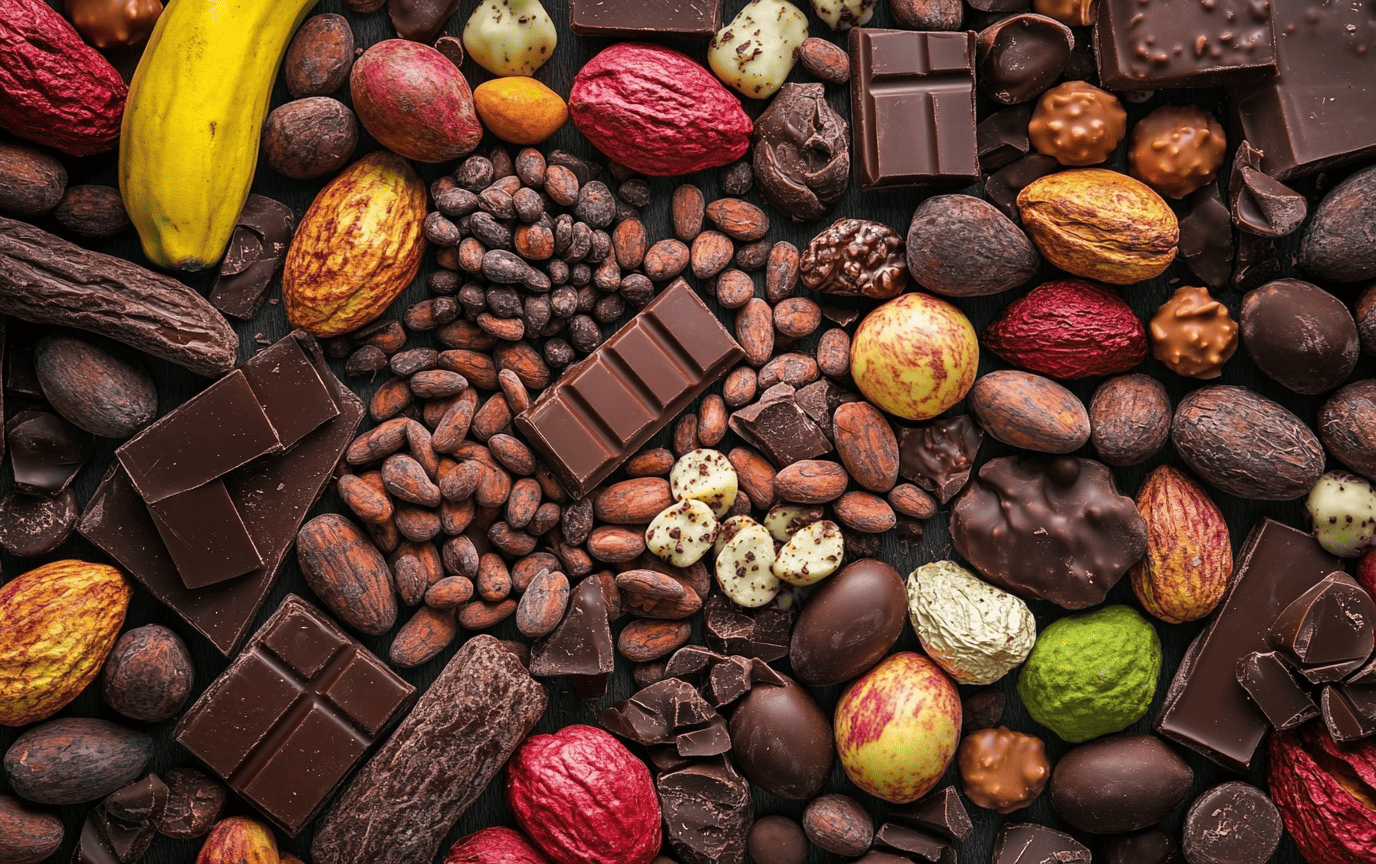The World of Chocolate: From Bean to Bar
Chocolate, a treasure wrapped in bright foil and childhood dreams, is more than just a confection; it’s a journey—a sensory journey that tantalizes our taste buds and warms our hearts. Each piece tells a story, echoes the rhythms of the tropical rainforests where cacao trees grow, and invites us to fall in love with its rich complexity. It is a tale colored by the hands of artisans, the whispers of history, and the indulgence of flavor. Let’s embark on this delicious voyage and explore the intriguing realm of chocolate making.
A Sweet Beginning: Harvesting and Fermentation
It all starts in tropical climates, where the Theobroma cacao tree stands tall, bearing fruits that cradle sacred seeds—the cacao beans. Imagine walking beneath a lush canopy, warm sunlight filtering through vibrant green leaves, as you spot the colorful cacao pods dangling like ornaments. You twist one off and crack it open, a tantalizing aroma wafting up to greet you. Inside, the beans are encased in a sweet, white pulp.
Once harvested, the beans are extracted and covered with their pulp, ready for fermentation. This phase lasts between 3 to 6 days, where the magic begins. Yeasts and bacteria feast on the sugars, crafting flavors that range from fruity to nutty. I recall the first time I visited a cacao farm. Standing amidst the fermentation bins, I could feel the excitement in the air as the local farmers shared their pride in the flavors they coaxed from those humble beans. The scent was intoxicating—like sweet, tangy ambrosia.
Drying: The Dance of Sun and Air
The fermentation process is just the beginning. Afterward, the cacao beans are laid out under the sun to dry, achieving a delicate balance of moisture—6 to 8 percent. This step is vital. As sunlight kisses those beans, they become less susceptible to mold—a skillful waltz with nature.
I remember helping a farmer spread beans on mats, the warmth of the sun on my back. Each bean represented a world of possibility, waiting for the right hand to mold it into something extraordinary. The little crunchy shells, remnants of their former fruity home, would soon cocoon the rich heart within.
Roasting: Flavors Unleashed
Once dried, the beans are cleared for roasting. This critical step takes place between 120°C and 140°C, during which, through a series of Maillard reactions, flavor compounds burst forth like fireworks in the night sky. The warm, nutty aroma that fills the room is nothing short of euphoric. You can almost taste the chocolate in the air.
I’ll never forget visiting a chocolate factory where the unmistakable scent enveloped me as if I were walking through a dream. The excitement of roasting was contagious; chocolatiers shared their techniques, how just a few minutes longer might spark deep, earthy notes or a haunting familiarity of caramel.
Winnowing and Grinding: The Transformation
After roasting comes the alchemy of winnowing. As the once-robust shells are cracked and discarded, cacao nibs emerge—small, dark nuggets full of potential. A simple grind transforms these nibs into chocolate liquor, a silky-smooth paste brimming with possibilities.
With each grind, the texture evolves. The joy of watching someone pour the cocoa mass into a mixer for the first time is exhilarating. You can see everyone lean in, waiting for the liquid to cool, its sheen shimmering like satin—a promise of the delicious creation to come.
Conching: The Art of Refinement
Herein lies the heart of chocolate making: conching. The chocolate liquor, agitated and aerated, is transformed further. It’s akin to an artist chiseling away at a rough block of marble, revealing the exquisite shape within. This phase can last hours or even days, gradually eliminating unwanted bitterness and allowing flavors to bloom. The laughter of the chocolatiers fills the air as they test batches. “Just a bit longer!” they say, as if coaxing the chocolate to share its secrets.
As I stood there, tasting spoonfuls of warm conched chocolate, I realized this wasn’t just a skill; it was a labor of love—a dedication to creating something pure.
Tempering and Moulding: A Finish with Flair
Lastly, the final dance: tempering. This controlled heating and cooling process gives chocolate its signature snap, the glossy sheen that beckons you. Tempering is as much a science as it is an art. With each careful movement, the chocolatiers create a symphony, their hands guiding the molten chocolate lovingly into molds, where it would soon harden into beautiful bars and delicate shapes.
I can still recall how the first tempered block I held shimmered, as if it was a gem found in a treasure trove. It was clear that each piece was a work of art, crafted with precision.
The Craft Chocolate Revolution: A New Era
In recent years, a revolution has gripped the world of chocolate—a focus on craft. No longer just mass-produced, chocolate is now hailed as artisan, where origin matters just as much as flavor. This bean-to-bar movement emphasizes quality and ethical sourcing, shedding light on the farmers who nurture cacao trees.
Walking through a craft chocolate fair, I was entranced by the variety. Each booth was like a new world, filled with stunning flavors and unique textures. One chocolatier handed me a bar infused with chili and sea salt; with each bite, I realized that flavor could truly evoke emotion. It was a promise and a memory, a reminder that chocolate tastes different when you know the story behind it.
Food and Wine: Chocolate’s Perfect Companions
The experience of chocolate tasting intertwines beautifully with food and wine. Pairing chocolate with wines can elevate both elements into an extraordinary gastronomic experience. Imagine the rich, velvety chocolate bar enveloping your palate while sipping on a fragrant red wine—where each note dances together in harmony.
During one delectable evening, I paired dark chocolate with a fruity Merlot. The chocolate seemed to spark the wine’s berry flavors, creating an intoxicating fusion. I sat there with friends, laughing and cheerfully discussing the perfect pairing, memories mingling with tastes.
Lifehacks: Mastering the Chocolate Experience
As seasoned travelers know, maximizing your chocolate experience can be an art in itself. Here are a few tips that can enhance your appreciation for the cacao delight:
- Plan a Chocolate Tour: Many regions are famous for their chocolate. Look for local tours that guide you through the bean to bar journey.
- Attend Tastings: Local artisan chocolatiers often offer tastings. Attend one, and you’ll learn so much about flavor profiles and textures!
- Seek Out Ethically Sourced Brands: When shopping, look for artisan chocolate that emphasizes fair trade practices and sustainable farming methods.
- Experiment with Pairings: Reshape your chocolate experience by pairing it with different beverages or even cheeses. You’ll discover a new world of flavor.
Throughout my travels, I’ve accumulated stories and flavors that shape my love affair with chocolate. With each sweet bite, I can taste the journeys—the hands that crafted it, and the lands that nurtured its growth.
Scenic Landscapes: The Origins of Chocolate
But the journey doesn’t end with a bite. Picture the lush hills of Ecuador, where the gentle breeze rustles cacao leaves, and the farmers smile proudly as they harvest their pride and joy. Imagine visiting these landscapes—tropical paradise where time seems to stand still, and the sounds of nature intertwine with the sweet scent of cacao.
I once took a trip to a cacao plantation in the heart of Peru. Surrounded by lush greenery, I learned how the environment influences flavor; the minerals in the soil create unique taste profiles, much like wine regions. This connection to place brings a deeper appreciation for every piece of chocolate I savor.
Conclusion
The journey from bean to bar is more than a mere process; it’s an epic story rich with culture, artistry, and history. Each textured layer of chocolate carries a whisper, inviting us to uncover its secrets. From the alluring cacao fields to the bustling craft factories, chocolate unites us through shared experiences and timeless flavors.
So, the next time you unwrap that tempting bar of chocolate, take a moment to reflect. Think of the hands that harvested and crafted it, envision the landscapes that birthed it, and allow it to blend into the memories of your adventures. After all, chocolate is meant to be savored, just like life itself.
Interested in more insightful reads? Check out our Travel Tips section for the latest advice. For lifestyle inspiration, explore our Lifestyle category, and dive into amazing destinations at Destinations. Don’t forget to connect with us on YouTube, or follow our adventures on Instagram and Pinterest.
May your travels be sweet and every taste memorable!













